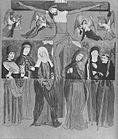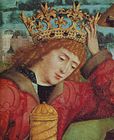Liesborn Altar

The Liesborn Altar ( high altar of the Liesborn monastery church ) is one of the main works of the Westphalian late Gothic . It is dated to the last third of the 15th century and stood there as a high altar in the choir room until the Liesborn monastery was dissolved . The sawn-up parts ended up in the Krüger Collection and with it in the National Gallery in London. Parts were resold through Christie's auction house . Other parts ended up in the LWL Museum for Art and Culture in Münster. This means that the fragments of the Liesborn Altar are just as scattered as the Marienfeld Altar .
history
The fragments of the Liesborn high altar came from a private collection of the 19th century, the Krüger Collection in Minden. The catalog of this collection from 1848 describes the painter of the pictorial works as Master of Liesborn . This emergency name has remained to this day. Some art historians, such as Reinhard Karrenbrock , suspect Johann von Soest to be behind this . The catalog puts several of the master's works of art in a workshop context, according to which there could have been a huge painter's workshop in Westphalia in the last third of the 15th century under the direction of this master. The Kruger catalog lists the Liesborn monastery church, a demolished chapel in Lippstadt and the Liesborn monastery as the places of origin of the pictures. Since no evidence was found in the monastery archives, this catalog and the auction catalog provide the only information about the identity of the work of art that has emerged. For dating, the chronicle of the monastery was used, according to which the high altar was consecrated by Abbot Heinrich von Kleve in 1465 together with four other side altars. The description of the altar in the chronicle of the monk Witte refers to the high altar in Liesborn. It literally says:
"... novum chorum a Florino inchoatum, a Luberto praedecessore suo consumatum, tesudine cooperiut, polito lapide stavit, stallis novis artificiose exesis ornavit, ipsumque chorum cum summo altari in honore sanctae Dei Ganitricis Damisiani Mariae, sanctorum beatimique Symeon Damisiani prophet marya , patronorum monasterii anno Domini MCCCCLXV ipso die Visiationis B. Mariae Virginis com aliis quatour inferionis ecclesiae alteribus consecriari fecit, Quae quidem alteria appostis tabulis operose ornavit, ita auro coloribusque destinctis, ut ipsarum appr posset. "
The altar was sawn into 14 or more individual paintings in the course of the secularization and abolition of the monastery around 1807.
"Vandals dismembered the altar at the beginning of the 19th century, after the secularization of the Liesborn Monastery, presumably to be able to sell the parts better."
The components were "sold at ridiculous prices". In the meantime, used by a farmer as a lid for a flour box, the two side wings were split into four parts in 1834 and sold to London in 1854. Since the two side wings were not considered to be the work of the master, but rather workshop work, the National Gallery sold them through an auction in 1857. The eight essential parts remained in the possession of the National Gallery, London, since 1854, as part of a larger purchase of Westphalian art from the Middle Ages. Even then, this purchase began to emphasize the “beauty and importance” of a “Westphalian school” and the work of a Liesborn master .
description
The original Liesborn reredos showed Christ on the cross in the middle, surrounded by four floating angels who caught his blood in goblets. To the left of the cross stood Mary and the saints Cosmas and Damian (the saints of the Liesborn parish), to the right Johannes, saint Scholastica and saint Benedict (Liesborn was a Benedictine abbey in the late Middle Ages). The left part of the reredos showed the Annunciation , the birth scene , the adoration by the kings and the presentation in the temple . Only the image of the announcement and its representation have been completely preserved. The altar was probably not a winged altar , but the pictures were lined up next to each other. The exact composition of the altar can no longer be completely and unequivocally reconstructed, as it is only preserved in fragments. The middle picture was also fragmented.
photos
Reconstruction of the central panel after Paul Pieper
Reconstruction of the left part of the reredos after Paul Pieper
Offering in the Temple , London
John with Scholastica from Nursia and Benedict from Nursia , London
Mary with Cosmas and Damian , London
literature
- G. Gietmann: The Master of Liesborn . In: The Catholic Encyclopedia. New York 1910 (English)
- CG Heise: North German painting. Studies on their development history in the 15th century from Cologne to Hamburg . (Dissertation). Kiel 1916
- M. Ihmdal: The master of Liesborn . In: Heimatkatalog Beckum 1953, pp. 31–33.
- P. Pieper: The Liesborn Altar . In: Kunstchronik 6/1966
- P. Pieper: The master of Liesborn and the Liesborn panels . In: Westphalia - Hefte für Geschichte, Kunst und Volkskunde Volume 44 (1966), pp. 5–11
- P. Pieper: The Liesborn panels - catalog and reconstruction . In: Westphalia - Hefte für Geschichte, Kunst und Volkskunde Volume 44 (1966), pp. 12-19
- Th. Rensing: Comments on the master of Liesborn . In: Westphalia - Hefte für Geschichte, Kunst und Volkskunde Volume 44 (1966), pp. 22–54
- W. Koenig: Studies for the master of Liesborn with special consideration of the development history of the Liesborn high altar . Beckum 1974
- R. Karrenbrock: Johann von Soest, the master of Liesborn . In: Westphalia - Booklets for History, Art and Folklore Volume 66 (1988)
- S. Lüken: The Annunciation to Maria in the 15th and early 16th centuries . Göttingen 2000
- E.-U. Hammer: Monastic reform between person and institution: On the work of Abbot Adam Meyer von Gross St. Martin in Cologne (1454-1499) . (Dissertation, publications by the Max Planck Institute). Göttingen 2001
Web links
- National Gallery, London (Master von Liesborn, selection)
Individual evidence
- ^ Wieland Koenig, Studien zum Meister von Liesborn, Beckum 1974, p. 19
- ↑ see in particular H. Müller: The Dioceses of the Church Province of Cologne. The diocese of Münster 5. The canon monastery and Benedictine monastery Liesborn . Berlin 1967, p. 19f.
- ↑ DIE ZEIT No. 22, of May 27, 1966
- ↑ Petra Marx, LWL-Landesmuseum für Kunst und Kulturgeschichte, Münster, The work of art of the month, September 2012, quoted from Andreas Priever, notes on the fate of the high altar and the Holy Cross altar of the former monastery church in Liesborn, in Wallraf-Richartz-Jahrbuch LXV, 2004, pp. 301-314
- ^ H. Kornfeld: A Westphalian Altarpiece . In: The Burlington Magazine for Connoisseurs 62/361 (1933), p. 160
- ↑ E. Mackowsky: A Lost Altarpiece by the Master of Cap Mountain . In: The Burlington Magazine for Connoisseurs. 65/378 (1934), p. 126ff.
- ↑ cf. P. Pieper: The Liesborn Altar . In: Kunstchronik 6/1966 and further R. Brandl: The Liesborn Altar-Piece: A New Reconstruction, Burlington Magazine 135 (1993), pp. 180-189













